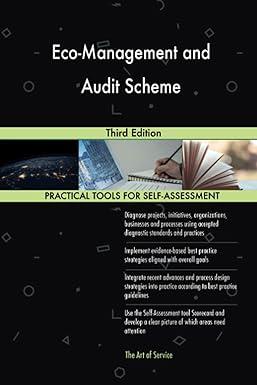Question
1. Use of capacity levels based on demand A) results in a price that covers the cost of capacity customers expect to pay. B) highlights
1. Use of capacity levels based on demand A) results in a price that covers the cost of capacity customers expect to pay. B) highlights the cost of capacity acquired but not used. C) yields a cost rate that does not include a charge for unused capacity. D) hides the amount of unused capacity.
2. Which of the following best describes how fixed cost are treated in a variable cost method? A) They are part of the product cost B) They are excluded from inventory cost and are treated as period costs C) They are allocated to the product cost using a denominator-level capacity choice D) They are classified as nonmanufacturing costs
3. Leelaland Inc, makes a product with the following costs per unit: Direct materials $100 Direct labor $30 Manufacturing overhead (variable) $30 Manufacturing overhead (fixed) $130 Marketing costs $75 What would be the inventoriable cost per unit under variable costing and what would it be under absorption costing? A) $160 for variable costing and $290 under absorption costing B) $230 for variable costing and $305 under absorption costing C) $230 for variable costing and $360 under absorption costing D) $200 for variable costing and $305 under absorption costing
4. The Tomlinson Company manufactures trendy, high-quality, moderately priced watches. As Tomlinsons senior financial analyst, you are asked to recommend a method of inventory costing. The CFO will use your recommendation to prepare Tomlinsons 2017 income statement. The following data are for the year ended December 31, 2017: Beginning inventory, January 1, 2017 90,000 units Ending inventory, December 31, 2017 34,000 units 2017 sales 433,000 units Selling price (to distributor) $25.00 per unit Variable manufacturing cost per unit, including direct materials $5.40 per unit Variable operating (marketing) cost per unit sold $1.20 per unit sold Fixed manufacturing costs $1,852,200 Denominator-level machine-hours 6,300 Standard production rate 60 units per machine-hour Fixed operating (marketing) costs $1,130,000 Required: Assume standard costs per unit are the same for units in beginning inventory and units produced during the year. Also, assume no price, spending, or efficiency variances. Any production-volume variance is written off to cost of goods sold.
1. Prepare income statements under variable and absorption costing for the year ended December 31, 2017. 2. What is Tomlinsons operating income as percentage of revenues under each costing method? 3. Explain the difference in operating income between the two methods.
Step by Step Solution
There are 3 Steps involved in it
Step: 1

Get Instant Access to Expert-Tailored Solutions
See step-by-step solutions with expert insights and AI powered tools for academic success
Step: 2

Step: 3

Ace Your Homework with AI
Get the answers you need in no time with our AI-driven, step-by-step assistance
Get Started


